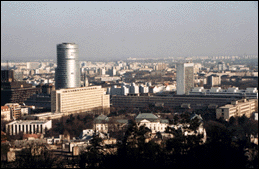 MACROECONOMIC INSIGHT MACROECONOMIC INSIGHT |
The reintroduction of an economy based on free enterprise has been a difficult process in Slovakia. As much of the country's industrialization took place during the Communist era, many Slovakian industries were inefficient and produced goods that were not competitive in the world market. To modernize these industries and retrain workers has required foreign investment, but this has been slow in coming, due in part to perceived political instability in the country.
The Slovak economy has improved somewhat in recent years. The pace of change remains slow, however. A fundamental part of the conversion to a market economy is the return of state-controlled enterprises to private ownership, which has been married by a non-transparent privatization process. In the period 1994 - 1998, domestic investors were preferred to foreign and the FDI flow to Slovakia was very weak. Many privatization scandals became evident in this period. "Tunneling" has become a word, describing non-transparent corporate governance, when owners and managers of private companies are taking companies` assets, leading the company to bankruptcy. Most of the "tunneled" companies were sold in very unclear circumstances from the state ownership to the new private owners for just a fraction of their real market price.
However, the privatization process is going on and it might be successfully finished in a few years. Political changes after 1998 brought more transparency into privatization, although the process still cannot be called transparent. Most of the less important national companies are sold. Apart from some exceptions, only some so-called strategic companies (especially utilities) remain in the hands of state. According to the privatization act, only 49 % of the strategic companies can be sold to investors.
The business environment is still in its transition and many obstructions remain from the communist mentality. Bureaucratization and corruption still take place at a far more significant level than in the Western countries.However, many good experiences from well-known multinational companies show that Slovakia is (although slowly) heading towards Western standard business environment. Deregulation of administered prices especially in the utilities sector is taking place; the restructuring process is going on. Tariffs remain low or non-existent; non-tariff barriers are being gradually removed under EU auspices.
Out of the macroeconomic indicators, unemployment is the most significant problem in Slovakia. The long-term unemployment rate is increasing and stays at 20 per cent. There are huge regional discrepancies among Slovak regions and towns. The unemployment rate in Bratislava is only natural (about 5 %), but there are some regions with unemployment rate reaching 50 %.
The economic growth (GDP) forecasts for Slovakia remain stable. The growth should remain stable at the level between 3 to 5 %. The GDP growth is pulled by personal and government consumption and fixed investments; the external sector is a drag for the growth, as imports strongly exceed exports. Inflation is steadily decreasing. Main factors of inflation are the deregulation of energy prices that has to be finished in 2004. The core inflation was about 3 - 4 % in 2001.
The external sector discrepancy has become the biggest
problem of Slovakia in 2001. In the long-term, the
current account deficit is forecasted to remain
at approximately 6 % of GDP. However, the structure
of imports shows that imports of capital goods are
growing rapidly, which can be a good basis for the
recovery of the foreign trade balance in the future.
The high trade and current account deficits are
caused mainly due to technology imports for both
green-field investments and modernization of existing
facilities. Slovak exports are strongly dependent
on a few companies; the most important one is Volkswagen
Bratislava. |

Slovak currency is Slovenska Koruna (SKK, Slovak crown). The exchange-rate regime is technically a free float, with the National Bank of Slovakia (the central bank) intervening only to prevent sharp short-term fluctuations. The reference currency for SKK is Euro.
Corporate income tax remains competitive in the region, but payroll taxes and compulsory insurance contributions remain too high. There is a remarkable shift to indirect taxes. The taxing policy is being adjusted and harmonized to EU principles.
There is a remarkable pressure for a tax and public expenditures reform in Slovakia. The long-term public expenditures, according to the IMF standard, are above 45 %.
One of the most important steps done in the near past was the restructuring of the Slovak-banking sector. The process is almost finished and strong foreign private banks are now operating in Slovakia. However, an enormous amount of bad loans, provided by state-owned banks in the period 1990 - 1998, had to be covered by issuing "restructuring bonds" totaling around SKK 105bn (half of the state budget).
In the past political stability was one of Slovakia's main problems. The election system is designed for the reign of government coalitions. However, most political parties are committed to the goal of EU membership, which will help to keep economic policy and structural reforms roughly on course, despite deep internal divisions within the government. Slovakia has made good progress in the EU accession talks and should be able to join the Union in the first round of eastward enlargement around 2004 or 2005. In the Slovak Cabinet, both Minister of Foreign Affairs and Deputy Prime Minister for EU Integration are responsible for the integration process. There is a sizeable risk that a return to power of Vladimir Meciar could derail Slovakia's form both EU and NATO accession bids.
Slovakia is a member of the International Monetary
Fund (IMF) and the International Bank for Reconstruction
and Development (World Bank), as well as of the
European Bank for Reconstruction and Development
(EBRD). In October 1993 the Slovak government signed
an association agreement with the European Union
(EU), in 1995 applied for membership and formal
negotiations were started in 1999. In 2000 the country
became a member of OECD. |

